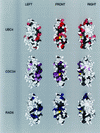Creation of a pluripotent ubiquitin-conjugating enzyme
- PMID: 11533242
- PMCID: PMC99800
- DOI: 10.1128/MCB.21.19.6537-6548.2001
Creation of a pluripotent ubiquitin-conjugating enzyme
Abstract
We describe the creation of a pluripotent ubiquitin-conjugating enzyme (E2) generated through a single amino acid substitution within the catalytic domain of RAD6 (UBC2). This RAD6 derivative carries out the stress-related function of UBC4 and the cell cycle function of CDC34 while maintaining its own DNA repair function. Furthermore, it carries out CDC34's function in the absence of the CDC34 carboxy-terminal extension. By using sequence and structural comparisons, the residues that define the unique functions of these three E2s were found on the E2 catalytic face partitioned to either side by a conserved divide. One of these patches corresponds to a binding site for both HECT and RING domain proteins, suggesting that a single substitution in the catalytic domain of RAD6 confers upon it the ability to interact with multiple ubiquitin protein ligases (E3s). Other amino acid substitutions made within the catalytic domain of RAD6 either caused loss of its DNA repair function or modified its ability to carry out multiple E2 functions. These observations suggest that while HECT and RING domain binding may generally be localized to a specific patch on the E2 surface, other regions of the functional E2 face also play a role in specificity. Finally, these data also indicate that RAD6 uses a different functional region than either UBC4 or CDC34, allowing it to acquire the functions of these E2s while maintaining its own. The pluripotent RAD6 derivative, coupled with sequence, structural, and phylogenetic data, suggests that E2s have diverged from a common multifunctional progenitor.
Figures






Similar articles
-
A chimeric ubiquitin conjugating enzyme that combines the cell cycle properties of CDC34 (UBC3) and the DNA repair properties of RAD6 (UBC2): implications for the structure, function and evolution of the E2s.EMBO J. 1992 Aug;11(8):3091-8. doi: 10.1002/j.1460-2075.1992.tb05381.x. EMBO J. 1992. PMID: 1639076 Free PMC article.
-
Identification of a portable determinant of cell cycle function within the carboxyl-terminal domain of the yeast CDC34 (UBC3) ubiquitin conjugating (E2) enzyme.EMBO J. 1992 Aug;11(8):3081-90. doi: 10.1002/j.1460-2075.1992.tb05380.x. EMBO J. 1992. PMID: 1639075 Free PMC article.
-
A site-directed approach for constructing temperature-sensitive ubiquitin-conjugating enzymes reveals a cell cycle function and growth function for RAD6.J Biol Chem. 1991 Dec 15;266(35):24116-20. J Biol Chem. 1991. PMID: 1748683
-
The structure and function of RAD6 and RAD18 DNA repair genes of Saccharomyces cerevisiae.Genome. 1989;31(2):597-600. doi: 10.1139/g89-111. Genome. 1989. PMID: 2698834 Review.
-
Cell cycle regulation by the ubiquitin pathway.FASEB J. 1997 Nov;11(13):1067-75. doi: 10.1096/fasebj.11.13.9367342. FASEB J. 1997. PMID: 9367342 Review.
Cited by
-
Tumor suppressor candidate TSSC5 is regulated by UbcH6 and a novel ubiquitin ligase RING105.Oncogene. 2006 Mar 2;25(9):1330-9. doi: 10.1038/sj.onc.1209167. Oncogene. 2006. PMID: 16314844 Free PMC article.
-
Genome-Wide Identification, Phylogenetic and Expression Analyses of the Ubiquitin-Conjugating Enzyme Gene Family in Maize.PLoS One. 2015 Nov 25;10(11):e0143488. doi: 10.1371/journal.pone.0143488. eCollection 2015. PLoS One. 2015. PMID: 26606743 Free PMC article.
-
Polyubiquitination by HECT E3s and the determinants of chain type specificity.Mol Cell Biol. 2009 Jun;29(12):3307-18. doi: 10.1128/MCB.00240-09. Epub 2009 Apr 13. Mol Cell Biol. 2009. PMID: 19364824 Free PMC article.
-
Cue1p is an activator of Ubc7p E2 activity in vitro and in vivo.J Biol Chem. 2008 May 9;283(19):12797-810. doi: 10.1074/jbc.M801122200. Epub 2008 Mar 5. J Biol Chem. 2008. PMID: 18321851 Free PMC article.
-
The available SRL3 deletion strain of Saccharomyces cerevisiae contains a truncation of DNA damage tolerance protein Mms2: Implications for Srl3 and Mms2 functions.Internet J Microbiol. 2009;8(1):8. doi: 10.5580/42c. Internet J Microbiol. 2009. PMID: 24795789 Free PMC article.
References
-
- Chen P, Johnson P, Sommer T, Jentsch S, Hochstrasser M. Multiple ubiquitin-conjugating enzymes participate in the in vivo degradation of the yeast MATα2 repressor. Cell. 1993;74:357–369. - PubMed
-
- Cook W J, Jeffery L C, Sullivan M L, Vierstra R D. Three-dimensional structure of a ubiquitin-conjugating enzyme E2. J Biol Chem. 1992;267:15116–15121. - PubMed
-
- Cook W J, Jeffery L C, Xu Y, Chau V. Tertiary structures of class I ubiquitin-conjugating enzymes are highly conserved: crystal structure of yeast UBC4. Biochemistry. 1993;32:13809–13817. - PubMed
-
- Cook W J, Martin P D, Edwards B F, Yamazaki R K, Chau V. Crystal structure of a class I ubiquitin conjugating enzyme (UBC7) from Saccharomyces cerevisiae at 2.9 angstroms resolution. Biochemistry. 1997;36:1621–1627. - PubMed
Publication types
MeSH terms
Substances
LinkOut - more resources
Full Text Sources
Molecular Biology Databases
Research Materials
